| Jaltomata pallascana (Bitter) Mione |
Peru |
this page revised 22 Aug 2013 |
| Link to the Jaltomata of Ancash, Peru |
The information on this page may be cited as a communication with professor Thomas Mione, Central Connecticut State University, Biology Department, Copernicus Hall, 1615 Stanley Street, New Britain, Connecticut 06050-4010, United States of America. |
|
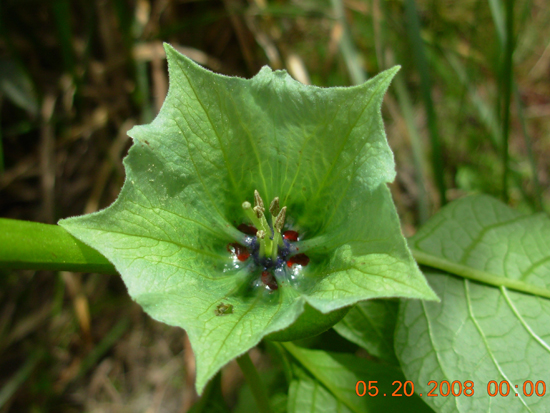 |
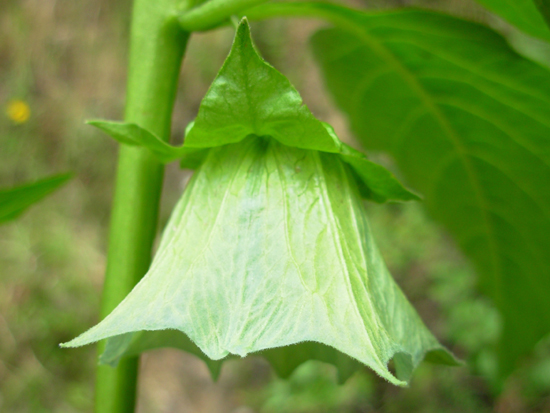 |
Figure 1. Front view of flower with red nectar in wells at base of corolla. All five anthers have dehisced. Stigma, immediately to the left of dehisced anthers, has pollen on it. Calyx hidden by corolla. Note radial thickenings extending from androecium toward corolla lobules; these create pools / pockets that hold nectar between them
(Photo by Thomas Mione, Mione et al. 790) |
Figure 2. Flower in side view; both corolla lobes and lobules (alternating with each other) are evident at bottom of photo; shape of calyx lobe is shown at top center
(Photo by Mione, Mione et al. 790) |
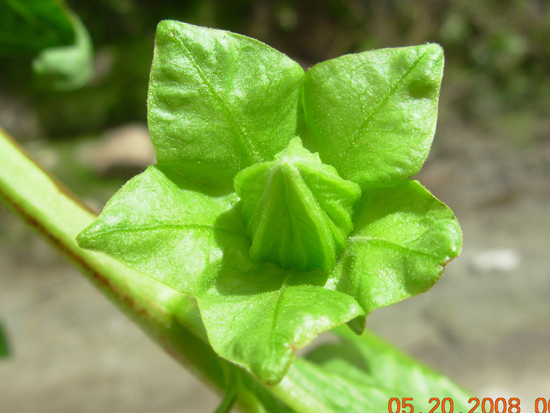 |
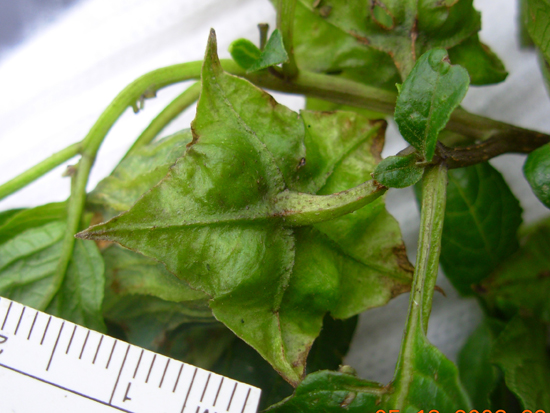 |
Figure 3. Flower Bud. Calyx wide open, corolla closed
(Photo by Thomas Mione, Mione et al. 790). |
Figure 4. Back of calyx. Where two sepals meet there is a keel that protrudes opposite the direction of the corolla, and that pedicel is angular in cross section (not terete). (Smallest units on ruler are mm, Photo by Mione, Mione et al. 783). |
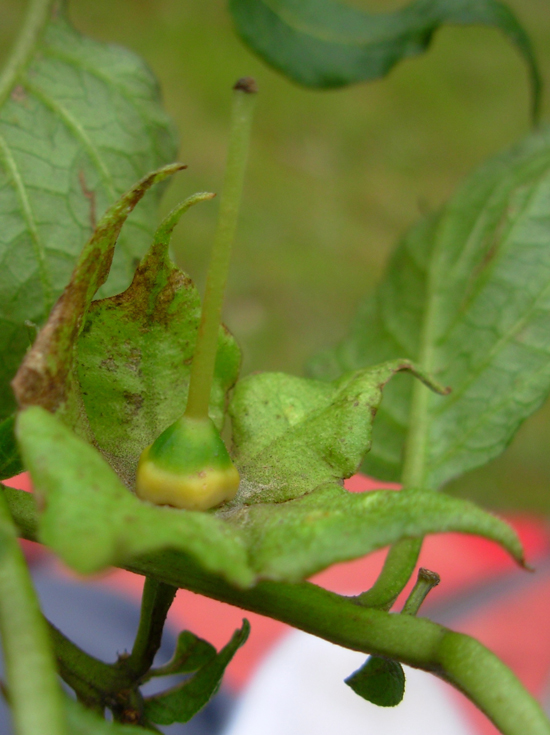 |
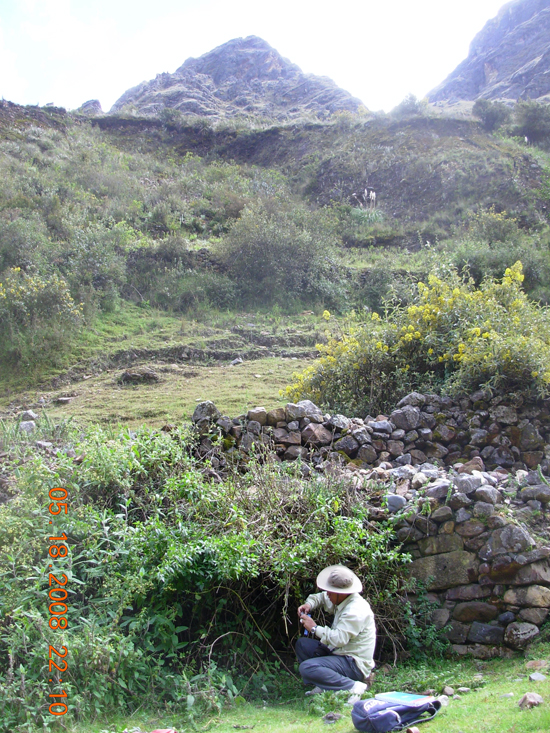 |
Figure 5. Gynoecium and calyx (corolla with attached androecium had already dropped). Disk around base of ovary is orange. Stigma at top of style is darker than style. Four calyx lobes are evident and the 5th is out of focus and closest to viewer.
(Photo by Mione, Mione et al. 783) |
Figure 6. Jaltomata pallascana plants growing in/on rock wall at or very near type locality (Photo by Thomas Mione, Mione et al. 783, Segundo Leiva G. is at plants). |
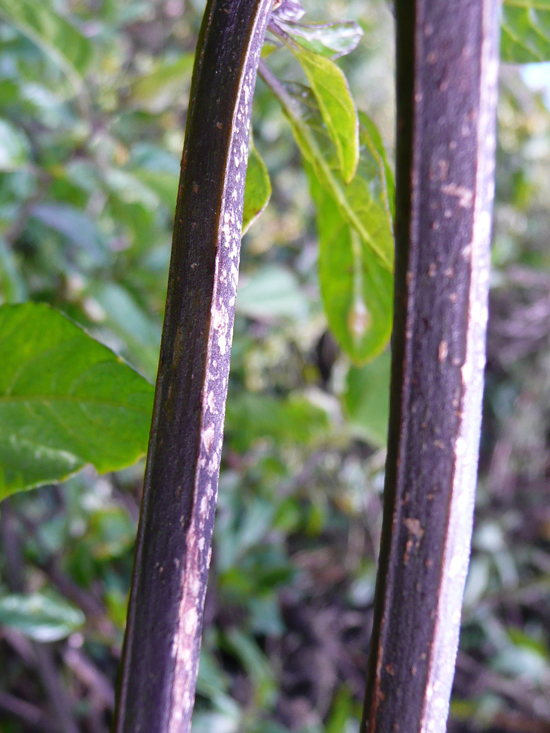 |
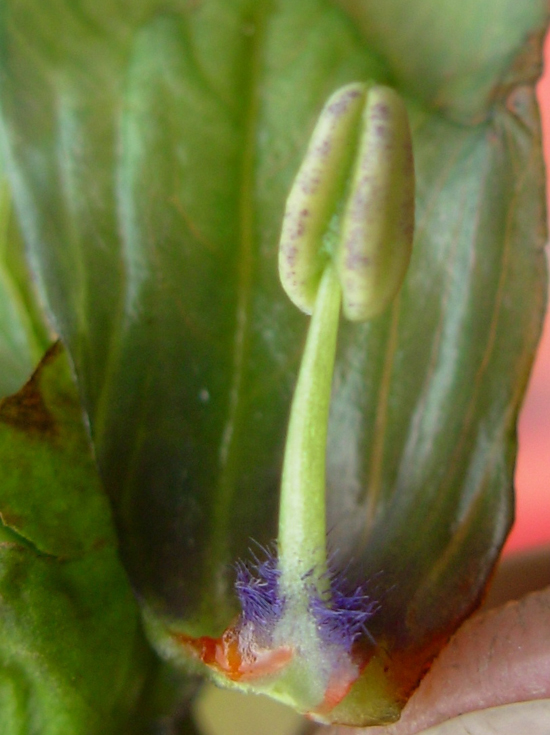 |
Figure 7. Stems of intermediate age
(Photo by Segundo Leiva G., Mione et al. 783) |
Figure 8. Stamen as viewed from gynoecium (ventral view). Note filaments insert on the ventral face of the anther as in all of the members of this genus. Hairs are purple, unbranched and grow only at the base of the filament (Photo by Mione, Mione et al. 783) |
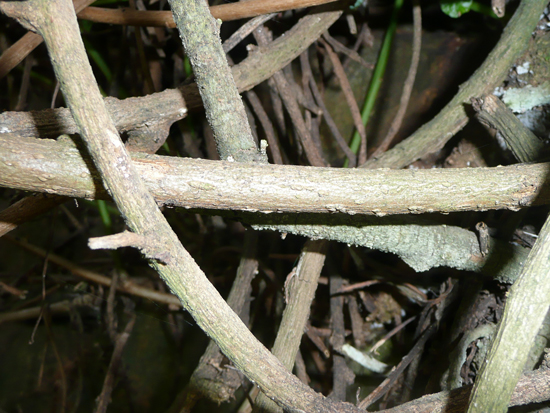 |
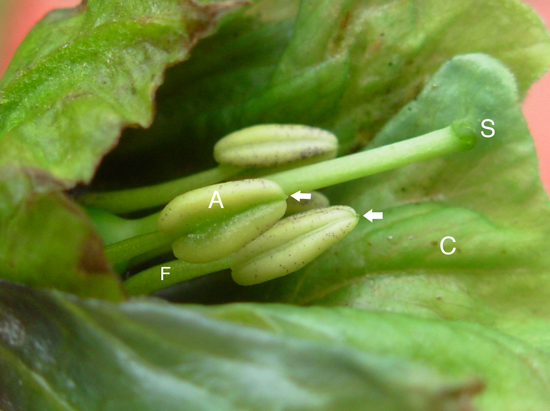 |
Figure 9. Oldest stems
(Photo by Segundo Leiva G., Leiva 4429 = Mione et al. 783) |
Figure 10. Corolla "C." White arrows point to the mucro on the end of the anthers, not present in all populations of this species studied in northern Ancash, Peru. Anthers "A" are undehsiced and yellow with purple dots; the lowest anther shows, toward viewer, a line where longitudinal dehiscence takes place. Filament "F." Stigma, darker green that the style, is immediately to the left of "S" (Photo by Thomas Mione, Mione et al. 783). |
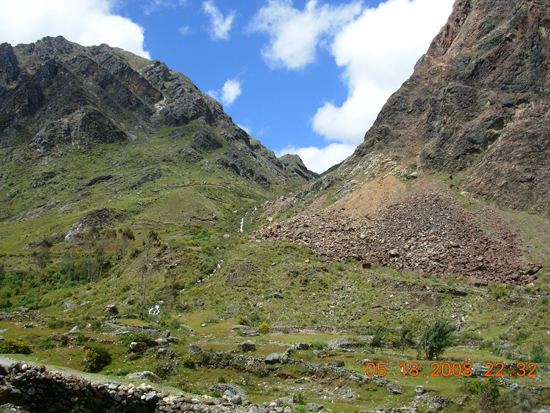 |
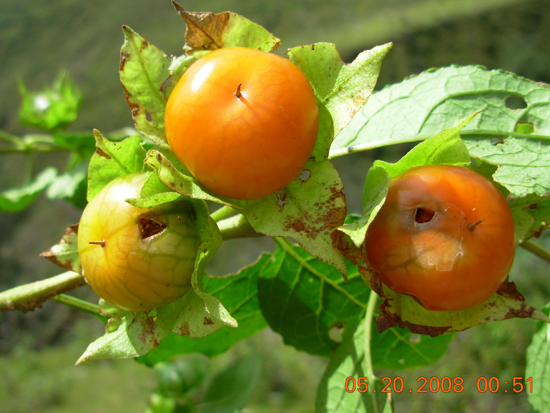 |
Figure 11. View across valley from plants of Jaltomata pallascana.
(Photo by Mione, at or very near type locality, Mione et al. 783). |
Figure 12. Ripe Fruits. One fruit collected in Peru was 21.5 to 22 mm (depending on how you rotate the berry) by 15 mm (pedicel attachment to opposite pole) and contained 301 seeds (Photo by Mione, Mione et al. 790). |
| |
History |
Literature Citation |
| 1920 |
Weberbauer collected the specimen that would become the type specimen,Weberbauer 7225 |
|
| 1924 |
Bitter erected a new subspecies, Saracha weberbaueri subspecies pallascana, using Weberbauer 7225 as the type specimen.
Bitter wrote (translated from German): "Department of Ancash, province Pallasca, over Yungabal, in the valley of Rio Pelagatos, in an area with bushes alternating with patches of grass, not common, 3,600 - 3,700 m, 29 Mar 1920, flowering and fruiting, Weberbauer 7225.
Bush to 2 m, supports itself by utilizing other bushes; flower light green but in bottom of inside blue-greenish, at bottom of stamen found two violet glands which secrete a large amount of blood-red sap [see first photo above ]. Stamens at bottom have violet hairs [see photo above]. Pools of nectar (5) form because structural parts in base form wells/pools [see first photo above ]. If shake, floral nectar splashes out and around, with older age more floral nectar. After pollination nectar production decreases greatly or stops. The nectar has no taste. This subspecies is distinguished by smaller leaves, shorter peduncle and pedicel, and flowers are smaller." |
Repertorium Specierum Novarum Regni Vegetabilis 19: 267-269.
(Repert. Spec. Nov. Regni Veg.) |
| 1930 |
Macbride elevated Saracha weberbaueri Dammer subspecies pallascana Bitter to the level of species, as S. pallascana (Bitter) Macbride |
Field Museum of Natural History, Botanical Series 8(2): 109. (Field Mus. Nat. Hist., Bot. Ser.) |
| 1940 - 1945 |
The type specimen Bitter (in the protologue) mentions seeing was almost certainly destroyed during WWII. |
|
| year unknown |
C. V. Morton was in agreement with Macbride (1930) that this taxon should be recognized at the level of species, not subspecies. |
unpublished notes |
| 1962 |
J. F. Macbride placed Saracha weberbaueri Dammer subspecies pallascana in synonymy with Saracha weberbaueri Dammer, the latter now known as Jaltomata weberbaueri. |
Flora of Peru. Field Mus. Nat. Hist., Bot. Ser. 13: Part V-B, No. 1. |
| 1992 |
Mione and F. G. Coe, following Macbride (1962), incorrectly placed S. weberbaueri Dammer subsp. pallascana Bitter in synonymy with Jaltomata weberbaueri (Dammer) Mione |
Novon 2: 383-384. |
| 1996 |
Aída Alvarez excluded this taxon from Saracha, in her masters thesis, on pages 104 and 108. |
Systematics of Saracha (Solanaceae). University of Missouri-St. Louis. |
| 2008 |
Mione, Leiva G. and L. Yacher went to the type locality and took the photos shown on this page. Based on the absence of specimens in herbaria, it looks like we are the first botanists to visit this area since Weberbauer in 1920. |
Arnaldoa 15(2): 285-288. |
Discussion: Georg Bitter described a new subspecies: Saracha weberbauer Dammer subspecies pallascana. Mione studied Bitter’s (1924) paper and determined that the described species is a Jaltomata, not a Saracha. To confirm this, in May of 2008 Mione, Leiva G. and Yacher went to the type locality, in the difficult to reach northern edge of the department of Ancash. We are apparently the first botanists to collect this species since the type specimen was collected 88 years ago, and the first to photograph the large green flowers having bright red nectar (photos above and described in the protologue). This taxon has been poorly known in part because the holotype was destroyed in Berlin during World War II. Based on our field studies we conclude that it was correct for Macbride (1930) to have treated this taxon as a species. However, it was incorrect for Macbride (1962) to have placed this taxon in synonymy with S. weberbaueri Dammer, the latter now Jaltomata weberbaueri (Dammer) Mione. Mione and Coe (1992), following Macbride (1962), incorrectly placed S. weberbaueri Dammer subsp. pallascana Bitter in synonymy with Jaltomata weberbaueri (Dammer) Mione. Alvarez (1996) correctly listed this taxon among those excluded from the genus Saracha.
Variation Seen Within The department Ancash, Peru: The corolla can look 10-lobed (lobes and lobules alternating) as in the top-right photo above, or the corolla can look 5-lobed (pistillate phase flowers of population 784), and collection 791 was described as 5-lobed in the field but the same flowers studied here with a dissecting microscope were considered weakly 10-lobed. Anthers were mucronulate in populations 783 and 784, but a mucro was lacking on the anthers of populations 790 and 791. Purple dots were seen on the yellow anthers of populations 783 and 791 (showing in photo above), but these were lacking in populaion 784 (data not available for population 790). Leaf size varies markedly among these collections as well: 783 has small leaves while 784 (just a few km away) has large leaves.
Taxonomy: Jaltomata pallascana (Bitter) Mione, Arnaldoa 15(2): 285-288, 2008. Saracha weberbaueri Dammer subspecies pallascana Bitter, Repertorium Specierum Novarum Regni Vegetabilis 19: 267-269. 1924. TYPE: Peru, Department Ancash, province Pallasca, in the valley of Rio Pelagatos, in an area with bushes alternating with patches of grass, not common, 3,600 - 3,700 m, 29 Mar 1920, Weberbauer 7225 (B, destroyed, photos at NY & WIS, F neg. 2559; Isotypes F, US). Saracha pallascana (Bitter) Macbride. Field Museum of Natural History, Botanical Series 8: 110. 1930.
Specimens Examined:
Department
Province |
Locality |
elevation
|
habitat |
date |
collector |
Data Entry |
Ancash
Pallasca |
TYPE. over Yungabal, in the valley of Rio Pelagatos |
3,600- 3,700 m |
in an area with bushes alternating with patches of grass, not common |
29 Mar 1920 |
Weberbauer 7225 (Holotype destroyed, photos at NY & WIS, F neg. 2559; Isotypes F, US) |
July 2008 |
Ancash
Pallasca |
parked at 08 10' 39.4, 77 52' 34.2 and walked downhill (away from Lago Pelagatos) on road about 4 or 5 min |
3,390 m
(My altimeter) |
rock wall on edge of agricultural field, leaning on other plants |
19 May 2008 |
Mione, Leiva & Yacher 783
= Leiva, Mione & Yacher 4429 |
July 2008 |
Ancash
Pallasca |
small town known as Pasto Bueno, a few min by vehicle downhill from 08 10' 39.4, 77 52' 34.2 |
3,550 m (Segundo's altimeter) |
growing along the edge of a small agriculatural plot and roadside |
19 May 2008 |
Mione, Leiva & Yacher 784
= Leiva, Mione & Yacher 4433 |
July 2008 |
Ancash
Pallasca |
08 14' 45.1", 77 54' 18.8" |
3,352 m |
not recorded at the time of collection, but I think it was roadside |
20 May 2008 |
Mione, Leiva & Yacher 790
= Leiva, Mione & Yacher 4441 |
July 2008 |
Ancash
Pallascan |
between 08 14' 45.1", 77 54' 18.8" and Tauca |
3,500 m |
roadside, growing in/among other vegetation |
20 May 2008 |
Mione, Leiva & Yacher 791
= Leiva, Mione & Yacher 4442 |
July 2008 |
| Character |
Description |
Figures on this page |
Habit & Height |
Woody shrub 2 - 3 m high |
|
Branches, young |
|
|
older |
|
|
Leaves, size |
|
|
| shape |
|
|
| hairs |
|
|
| petiole |
|
|
Inflorescence |
|
|
peduncle |
|
|
pedicel |
|
|
Calyx at flowering |
|
|
| at fruit maturity |
|
|
Corolla color |
|
|
shape and size |
|
|
lobes/lobules |
|
|
|
|
|
|
yes (Mione et al. 783) |
|
Stamen length including anther |
|
|
| filaments |
|
|
| anther color |
|
|
| anther size |
|
|
| anther mucronate / mucronulate |
|
|
| insertion of filament into anther |
|
|
| anthers of a flower open simultaneously? |
|
|
| pollen quantity per flower |
124,519 (n = 1 flower, Mione et al 783)
342,500 (n = 1 flower, Mione et al 790) |
counts by Emmett P. Varricchio, 2012, flowers collected in Peru (not grown for study) |
| pollen grain size |
25 - 31.25 µm, mean 29 µm (Mione et al 783
27.25 - 30.75 µm, mean 28.8 µm (Mione et al 790
|
15 grains per collection, flowers collected in Peru and stored in 70% ethanol,
Michael J. Tanasi 2012 |
| corona |
no |
|
Stigma |
|
|
Style |
|
|
Ovary |
|
|
Ovules per ovary |
312 (Mione et al. 783, ovule count of one locule doubled )
362 (Mione et al. 790, ovule count of one locule doubled) |
counts by Thomas Mione, 2012, flowers collected in Peru (not grown for study) |
Nectar |
|
|
| Herkogamy |
|
|
| Protogyny |
|
|
Fruit color (at maturity) and size |
|
|
Seeds per fruit |
301 seeds were in a fruit 21.5 to 22 mm (depending on how you rotate the berry) by 15 mm (pedicel attachment to opposite pole) (Mione et al. 790); 193 seeds were in a berry 13.5 X 19, and 228 seeds in a berry 17 to 18 (depending on how your rotate the berry) by 14 mm (Mione et al. 783). |
|
Seed Size |
|
|
Chromosome number |
|
|
Growability in Connecticut, USA |
|
|
How long does it take from flower to ripe fruit? |
|
|
Self-Compatible? |
|
|
Seed Germination
|
|
|
Ratio of Pollen to Ovules |
399 to 945 (n = 2 flowers) |
|
| Character |
Description of Jaltomata pallascana |
Figures on this web page |
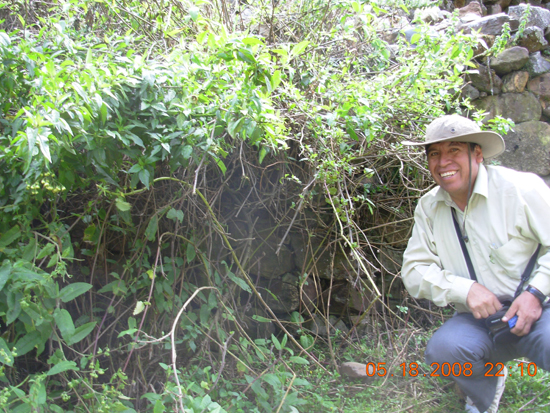 |
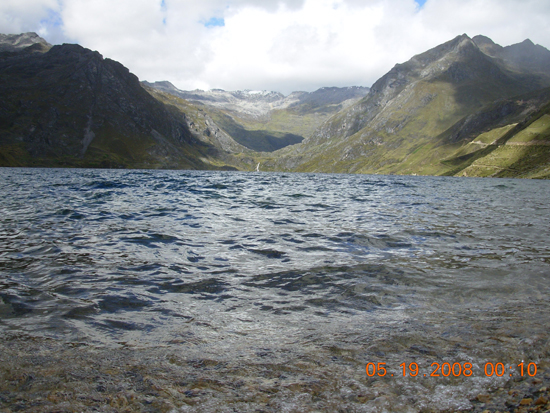 |
Figure 13. Plants of Jaltomata pallascana are immediately above Segundo Leiva's head. At or very near type locality, Photo by Thomas Mione, Mione et al. 783.
|
Figure 14. Lago Pellagatos, a few km up (higher than) collection locality 783. |
Literature Cited
